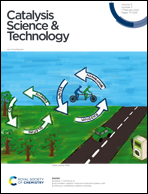Organocatalytic insertion into C–B bonds by in situ generated carbene: mechanism, role of the catalyst, and origin of stereoselectivity†
Abstract
The origin of stereoselectivity for BINOL-catalyzed insertion into the C(sp2)–B bond of alkylboronic ester by in situ generated carbene has been investigated using density functional theory (DFT). The reaction to form chiral α-CF3 allylboronic acid includes three stages: (1) formation of chiral alkenyl boronate, (2) carbene insertion into the C–B bond, and (3) dissociation of the BINOL catalyst. The carbene insertion has been proved to be the stereoselectivity-determining step, and the S-configurational pathway is more energetically favorable than the R-configurational approach. The quantum theory of atoms in molecules (QTAIM) analyses suggest that the C–H⋯X (X = I, Br) hydrogen bond interactions are the key factors for determining enantiomeric outcomes, and further electron localization function (ELF) and frontier molecular orbital (FMO) analyses reveal electronic structure changes over the carbene insertion coordinate. The obtained insights will be valuable for understanding other similar asymmetric constructions of C–B bonds, which helps design a better catalyst.



 Please wait while we load your content...
Please wait while we load your content...